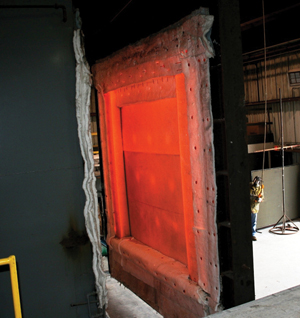Electrical Transformer Fire and Explosion Protection
ASTM E1529 vs. IBC
While the effects of large hydrocarbon pool fires on structural members have been determined through ASTM E1529-10 Standard Test Methods, the application requirements have yet to be reflected in building codes such as those set forth by International Building Code (IBC) or National Fire Protection Association (NFPA). The main deficiencies in the existing building and fire codes are the lack of distinction between the energy input rate, duration, and severity of solid fuel fires as compared to the hydrocarbon liquid fires tested for in ASTM E1529-10 and found in substation transformer fires. The result is a false belief that a firewall that meets NFPA 221-09, or 850 5.1.4.3, which specifies a 2-hour-rated firewall for temperatures up to 1200° F, is sufficient to withstand a hydrocarbon oil fire burning at temperatures as high as 2190° F for four hours. In real world conditions a hydrocarbon oil fire can last well over four hours before burning itself out. Any firewall not rated for a minimum four-hour high heat flux exposure at 2190° F would fail, some within the first five minutes of such exposure.
 |
Refractory concrete firewall test Photo courtesy of Alonso Rodriguez |
Material MattersÂ
Traditionally, firewalls are built from reinforced concrete and/or concrete blocks. When concrete made with common Portland cement (PCC) is exposed to temperatures above 1200° F, the cement becomes dehydrated and loses its structural integrity, retaining only about 35 percent of its room temperature strength.5 Firewalls made with traditional concrete materials and used in substation firewall applications have failed under the actual conditions of a transformer oil fire because these materials do not perform as needed under the extreme stesses commonly found in a hydrocarbon oil fire. For a transformer fire containment wall to be successful in real world conditions it must be made of a material that withstands the extreme heat flux and temperatures of an oil fire having a working temperature of between 1760° F and 2190° F for a minimum of four hours, followed immediately by a high-pressure water jet blast. One such material is refractory concrete.
Refractory Concrete
Refractory concrete refers to concrete made with refractory materials. Refractories are heat- resistant materials that have the ability to withstand sudden temperature changes, prolonged high temperatures as well as load and abrasive forces. High alumina cements and fireclay refractory materials such as crushed fire brick are commonly used as aggregate in refractory concretes. Refractory concrete is versatile in application and can either be cast in place or precast into relatively lightweight components to create a stable, high performance fire containment wall that retains considerable strength at temperatures up to 2372° F. Refractories emit no volatile organic compounds or hazardous material when exposed to prolonged high temperatures, and have been used for centuries to handle molten metal in foundries and smelters. Refractory concretes are designed to meet the thermal and mechanical requirements over the service life of an electrical substation.









